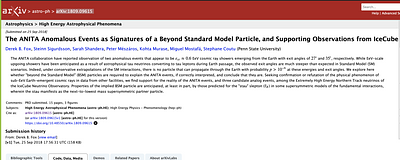By: Vivek Reddy Pininti, Gopal Bhatta, Sagarika Paul, Aman Kumar, Aayushi Rajgor, Rahul Barnwal, Sarvesh Gharat
We present a first systematic time series study of a sample of blazars
observed by the Transiting Exoplanet Survey Satellite $\textit{TESS}$
spacecraft. By cross matching the positions of the sources in the TESS
observations with those from Roma-BZCAT, 29 blazars including both BL Lacerate
objects and flat-spectrum radio quasars were identified. The observation
lengths of the 79 light curves of the sources, across all sectors on which the
t... more
We present a first systematic time series study of a sample of blazars
observed by the Transiting Exoplanet Survey Satellite $\textit{TESS}$
spacecraft. By cross matching the positions of the sources in the TESS
observations with those from Roma-BZCAT, 29 blazars including both BL Lacerate
objects and flat-spectrum radio quasars were identified. The observation
lengths of the 79 light curves of the sources, across all sectors on which the
targets of interest have been observed by $\textit{TESS}$, range between 21.25
and 28.2 days. The light curves were analyzed using various methods of time
series analysis. The results show that the sources exhibit significant
variability with fractional variability spanning between 1.41% and 53.84%. The
blazar flux distributions were studied by applying normal and lognormal
probability density function models. The results indicate that optical flux
histogram of the sources are consistent with normal probability density
function with most of them following bi-modal distribution as opposed to
uni-modal distribution. This suggests that the days-timescale optical
variability is contributed either by two different emission zones or two
distinct states of short-term activity in blazars. Power spectral density
analysis was performed by using the power spectral response method and the true
power spectra of unevenly sampled light curves were estimated. The power
spectral slopes of the light curves ranged from 1.7 to 3.2.
less
By: Derek B. Fox, Steinn Sigurdsson, Sarah Shandera, Peter Mészáros, Kohta Murase, Miguel Mostafá, Stephane Coutu (Penn State University)
The ANITA collaboration have reported observation of two anomalous events
that appear to be $\varepsilon_{\rm cr} \approx 0.6$ EeV cosmic ray showers
emerging from the Earth with exit angles of $27^\circ$ and $35^\circ$,
respectively. While EeV-scale upgoing showers have been anticipated as a result
of astrophysical tau neutrinos converting to tau leptons during Earth passage,
the observed exit angles are much steeper than expected in Stand... more
The ANITA collaboration have reported observation of two anomalous events
that appear to be $\varepsilon_{\rm cr} \approx 0.6$ EeV cosmic ray showers
emerging from the Earth with exit angles of $27^\circ$ and $35^\circ$,
respectively. While EeV-scale upgoing showers have been anticipated as a result
of astrophysical tau neutrinos converting to tau leptons during Earth passage,
the observed exit angles are much steeper than expected in Standard Model (SM)
scenarios. Indeed, under conservative extrapolations of the SM interactions,
there is no particle that can propagate through the Earth with probability $p >
10^{-6}$ at these energies and exit angles. We explore here whether "beyond the
Standard Model" (BSM) particles are required to explain the ANITA events, if
correctly interpreted, and conclude that they are. Seeking confirmation or
refutation of the physical phenomenon of sub-EeV Earth-emergent cosmic rays in
data from other facilities, we find support for the reality of the ANITA
events, and three candidate analog events, among the Extremely High Energy
Northern Track neutrinos of the IceCube Neutrino Observatory. Properties of the
implied BSM particle are anticipated, at least in part, by those predicted for
the "stau" slepton ($\tilde{\tau}_R$) in some supersymmetric models of the
fundamental interactions, wherein the stau manifests as the next-to-lowest mass
supersymmetric partner particle.
less

